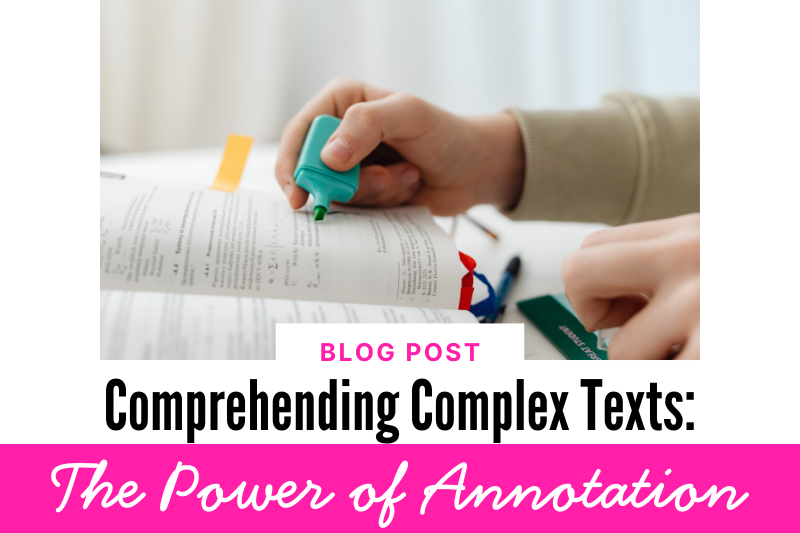Comprehending Complex Texts: The Power of Annotation
Interested in a FREE student reference page to support annotation?
Scroll down below for the link!
I still remember sitting at my dining room table in high school, staring at my biology textbook and trying to study for an upcoming exam. I had read the same page multiple times, but I was having trouble making sense of it all. The text felt dense and overwhelming, and I was lost in the volume of information.
My father noticed my frustration and gave me advice that changed the way I tackled challenging reading from that point forward:
“Don’t just ‘read’ it. Break it down, piece by piece. Slow down. Mark up the page. Just focus on understanding one small section at a time.”
So that’s what I did.
He showed me how to break the text into smaller chunks, circle key vocabulary (and figure out unknown words), and jot key ideas and insights in the margins. Although I didn’t fully understand it at the time, I can see now that annotating helped me slow down my thinking, manage cognitive load, and process the text at a deeper level. Instead of being overwhelmed by the “whole,” I began paying close attention to each small part. By marking up the page, I was actively processing the information and making meaning visible.
And it worked.
As a teacher now, I think about that moment often (over 20 years later!).
It was a defining moment in my own learning when I experienced the power annotation can have on comprehension. And it changed how I approach challenging reading material (still to this day, my nonfiction books are covered in definitions, questions, and ideas. In my opinion, it’s the sign of a well-loved and deeply understood text!).
Recent shifts in literacy practices have emphasized the need for all students to have access to rich, grade-level texts. (You can read more about this here). But as we move away from the “instructional level” reading model, we also need to equip students with the skills to tackle challenging reading material.
If we simply hand students challenging texts without appropriate scaffolding and support, many will silently struggle in exactly the same way I did. They will feel overwhelmed, overloaded, and unsure what to focus on.
Explicitly teaching annotation is one powerful way we can help students to slow thinking down, focus attention, and make meaning as they read.
When we explicitly teach students how to annotate well, we show them that annotation is not simply ‘drawing symbols’ on the page. It’s a powerful processing tool that helps to make thinking visible.
I developed this anchor chart and student reference tool (download your own free copy by clicking the link below!) specifically to support students as they unpack and annotate more challenging reading material. It provides symbols and prompts to help students pay attention to specific ways that texts can become complex (e.g. by noticing cohesion, identifying structure, breaking down vocabulary, applying morphemic awareness, and inferring meaning). These annotation prompts guide students toward the deeper work of comprehension: not just marking the page, but processing ideas.
Essentially, this tool shows students where to focus their attention when a text gets complex.
If you’d like a FREE copy of this student reference page, click here!
So, how might we teach annotation?
Dedicating time to modelling the process and demonstrating how a reader thinks through a complex text is essential if we want our students to experience success.
Here are some practical tips to consider when introducing annotation to your students:
Start small. Choose only a few symbols/prompts to begin with and model their use using a mentor text.
Begin with shorter texts, or even a single paragraph, to show students how a reader might break down complex writing.
Highlight that annotation is a thinking tool, not a decoration task!
Ensure that the printed texts students are working with have space on the page for margin notes and symbols.
Model how annotations can help readers identify text structure, support vocabulary knowledge, connect ideas, mark cohesion, and note key takeaways.
Guide students to jot down key takeaways, in their own words, at the end of each section, paragraph or page. (You may like to use the ‘5 word summary’ or ‘GIST’ strategy, depending on what your students are familiar with). This step is a powerful way to support retrieval, which helps to transfer important information from working memory into long-term memory.
Celebrate student agency! Each reader will annotate differently depending on the thinking work he or she is doing. Encourage students to use metacognitive markers that make sense to them. Allow students to choose whether they want to underline, highlight, use color-coding, or even sticky notes. When we allow students to personalize the process, it increases the liklihood that they will internalize the strategy and use it independently across other texts and contexts.
Keep in mind that it will take students time, practice and feedback to develop annotating skills. Don’t assume that all students will ‘get it’ after one or two goes. Ongoing guidance, practice, and encouragement is key!
Finally, it’s worth noting that not all students will find annotating helpful. The goal is not compliance with a strategy, but helping our readers discover approaches that genuinely aid their comprehension.
Ultimately, annotation is about slowing down, noticing more, and making thinking visible.
So, if you’re looking for a way to help your students confidently tackle complex texts, try teaching annotation skills! Annotation isn’t just a strategy. It’s a bridge to comprehension, clarity, and long-term understanding.





